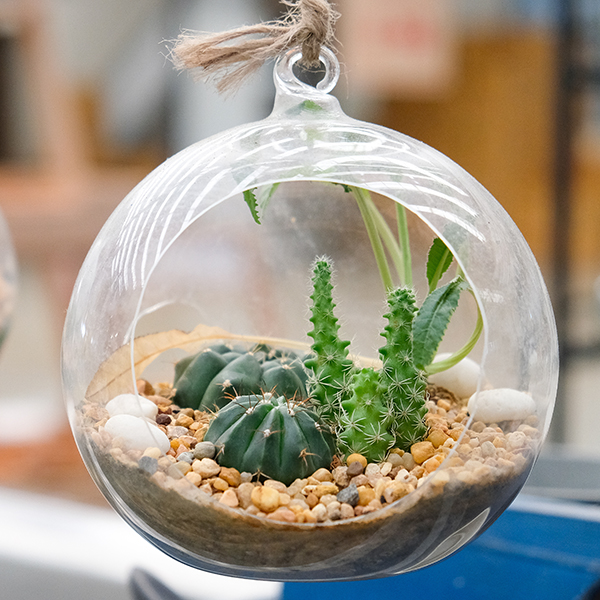
Hanging gardens are becoming increasingly popular as plant enthusiasts look to save valuable floor space by getting their plants up and off the ground. Not only are hanging gardens practical, but they are a great way to spice up your interior decor. Sure, you could just hang your plants from hooks on the ceiling – but there are endless possibilities when it comes to creating a hanging garden, so why not have some fun with it? From Kokedama to hanging terrariums, wall planters, and more, here are 9 unique ways that you can create a hanging garden in your home.
1. Wall Planters
What’s better than living wall art? Wall-mounted planters are easy to find at most home decor shops and nurseries, or you can make your own using some old containers and mounts. While most of these planters are watertight, it’s a good idea to remove them from the wall when it’s time to water the plants to ensure that water does not leak through the planters and damage the wall behind them.
2. Hang Plants from Old Clothing Rods
Repurposing clothing rods and racks as plant holders is a cheap and simple DIY. Plus, free-standing clothing racks are great for dorms and apartments where making holes in the wall or ceiling is not permitted. Use S-hooks and macrame holders or hanging planters to display your houseplants with style.
3. Create a Hanging Propagation Station
A hanging propagation station is a fun way to display your newest plant creations. Using glass or clear containers allows you to keep an eye on root development, although this is optional. The propagation vessels can be hung from the ceiling, an existing light fixture, curtain rods, or they can even be mounted to the wall.
4. Kokedama: Japanese Moss Balls
Kokedama is the practice of growing plants in moss-covered balls of soil. It originates from Japan and is distantly tied to the bonsai art form. Kokedama balls can be easily suspended from the ceiling with clear fishing twine or string, which creates a striking display. To water the Kokedama, you simply take them down and let the moss balls soak in a basin of water for 10-25 minutes.
5. Mounted Plants
This method is most commonly used for staghorn ferns but can technically be done with any trailing or hanging plant. Hoyas, philodendrons, ferns, and pothos are all good options. Wire mesh is used to hold the roots of the plant in place on the board along with some dirt and moss to keep everything contained. To water the plant, remove the board from the wall and use a spray bottle to moisten the root ball.
6. Create ‘Living Curtains’
Do you have a bright, sunny window that is looking a little bare? Save money on curtains and window dressings and use plants instead! Just be sure that the curtain rod is sturdy enough to hold the weight of several plants hanging off of it. It’s also important to ensure that the window you choose is not too drafty or cold, especially in the winter as this could cause the plants to die.
7. Succulent Wall Trays
Succulent wall trays are an easy and fun DIY that requires very little ongoing maintenance once they are put together. They are a great addition to any home interior, or they can be hung on an outdoor wall. Choose a shallow box (shadow boxes work well) and secure wire meshing across the top. Then, use soil and moss to hold the succulents in place. Succulent wall trays should be hung on a wall that receives bright, direct light.
8. Hanging Terrariums
Hanging terrariums are a fun and whimsical way to display some of your favorite plants. Ideal plants for terrariums include succulents, cacti, and humidity-loving plants such as ferns, ivy, and peperomia. If you are creating a terrarium with cacti and succulents, they will require very infrequent watering. For humidity-loving plants, regular watering and occasional misting will help to keep humidity high within the terrarium environment.
9. Repurpose a Canvas Shoe Organizer
Over-the-door canvas shoe organizers make great DIY hanging planters. Before planting, ensure that the insides of the canvas pockets are lined with plastic so that water does not seep through the canvas into the wall behind it.
Written by Cori Sears for The Spruce.com







